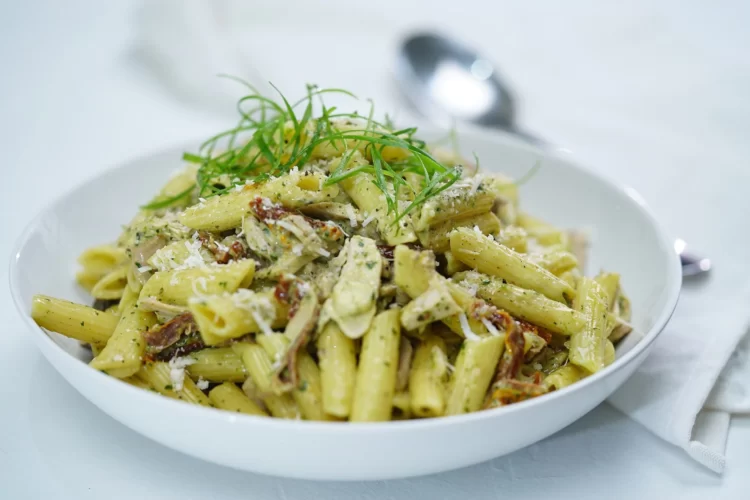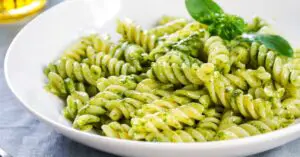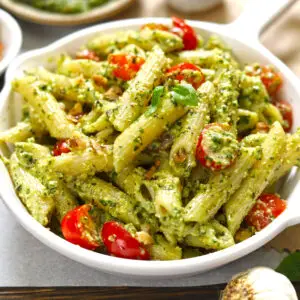Pesto pasta is a classic Italian dish that combines pasta with a flavorful sauce made from fresh basil, garlic, pine nuts, Parmesan cheese, and olive oil. It’s a delicious and versatile recipe that can be easily customized to suit your preferences. Here’s a basic recipe for pesto pasta:
Ingredients:
For the pesto sauce:
- 2 cups fresh basil leaves, packed
- 2-3 garlic cloves
- 1/4 cup pine nuts (or walnuts)
- 1/2 cup grated Parmesan cheese
- 1/2 cup extra virgin olive oil
- Salt and pepper to taste
For the pasta:
- 8 ounces (225 grams) of pasta noodles (such as spaghetti, linguine, or penne)
- Salt for boiling water
Optional toppings or additions:
- Additional grated Parmesan cheese
- Pine nuts (toasted)
- Cherry tomatoes (roasted)
- Grilled chicken
- Shrimp
- Sautéed vegetables (such as zucchini, mushrooms, or spinach)
Note:
The quantities mentioned above are approximate and can be adjusted based on your taste preferences and the number of servings you want to make.
Instructions:
prepare the Pesto Sauce:
- In a food processor or blender, add the basil leaves, garlic cloves, pine nuts (or walnuts), and grated Parmesan cheese.
- Pulse the ingredients a few times to break them down.
- While the processor is running, gradually pour in the olive oil in a steady stream until the mixture becomes smooth and well combined.
- Taste the pesto sauce and season with salt and pepper as needed. Adjust the flavors according to your preference. Set the sauce aside.
Cook the Pasta:
- Bring a large pot of salted water to a boil.
- Add the pasta noodles to the boiling water and cook them according to the package instructions until al dente (cooked but still firm to the bite).
- Once the pasta is cooked, drain it in a colander and reserve a small amount of the cooking water (about 1/4 cup) to loosen the sauce if needed.
Combine the Pasta and Pesto Sauce:
- Transfer the drained pasta back to the pot or a large mixing bowl.
- Add the prepared pesto sauce to the pasta and toss well to coat the noodles evenly. If the sauce is too thick, add a small amount of the reserved pasta cooking water to thin it out.
- Mix until the pasta is well coated with the pesto sauce.
Optional Toppings or Additions:
- If desired, you can sprinkle some additional grated Parmesan cheese and toasted pine nuts over the pasta for added flavor and texture.
- You can also incorporate roasted cherry tomatoes, grilled chicken, shrimp, or sautéed vegetables to enhance the dish. Simply add them to the pasta and gently toss to combine.
Serve and Enjoy:
- Divide the pesto pasta among serving plates or bowls.
- You can serve it as is or with a side of crusty bread or a fresh green salad.
- Enjoy your delicious homemade pesto pasta!
Remember, the instructions above are a basic guideline, and you can customize the recipe according to your taste and preferences. Feel free to adjust the quantities of the ingredients or add other ingredients that you enjoy.
Tips and Variation:
Tips:
- Use fresh and high-quality ingredients, especially for the basil and Parmesan cheese, as they greatly contribute to the flavor of the pesto sauce.
- Toast the pine nuts before adding them to the pesto sauce for a richer and nuttier flavor. Simply heat them in a dry pan over medium heat until they turn golden brown, stirring occasionally.
- If you don’t have a food processor or blender, you can make the pesto sauce by finely chopping the basil, garlic, and pine nuts, and then combining them with the grated Parmesan cheese and olive oil in a bowl. Use a fork or a whisk to mix everything together until well combined.
- To prevent the basil from turning brown, blanch the basil leaves in boiling water for about 10 seconds, then transfer them to an ice bath to cool before using them in the pesto sauce. This technique helps preserve the vibrant green color of the basil.
- Reserve some pasta cooking water before draining the pasta. Adding a little bit of starchy water to the sauce can help bind it to the pasta and create a smoother consistency.
Variations:
- Swap out the basil: While basil is the traditional herb used in pesto, you can experiment with different greens such as arugula, spinach, or even a combination of herbs like parsley and cilantro.
- Nut alternatives: Instead of pine nuts, you can try using walnuts, almonds, pistachios, or even sunflower seeds in the pesto sauce. Each nut will bring a unique flavor to the dish.
- Dairy-free pesto: If you prefer a dairy-free option, you can omit the Parmesan cheese or replace it with nutritional yeast for a cheesy flavor.
- Experiment with additional ingredients: Customize your pesto pasta by adding roasted cherry tomatoes, grilled chicken, sautéed shrimp, or a medley of sautéed vegetables like zucchini, mushrooms, or bell peppers.
- Whole wheat or gluten-free pasta: If you’re looking for a healthier or gluten-free alternative, you can use whole wheat or gluten-free pasta noodles in place of regular pasta.
- Pesto variations: Explore different types of pesto, such as sun-dried tomato pesto, roasted red pepper pesto, or even avocado pesto. These variations can add interesting flavors and colors to your pasta.
Remember, cooking is a creative process, so don’t hesitate to experiment and adjust the recipe to suit your taste preferences. Enjoy your pesto pasta adventure!
Serving Suggestion:
Plate Presentation:
- Transfer the pesto pasta onto individual serving plates or a large serving platter.
Garnish:
- Sprinkle some freshly grated Parmesan cheese over the top of the pasta. This adds an extra layer of flavor.
Additional Toppings:
- For added texture and visual appeal, you can sprinkle some toasted pine nuts over the pasta. They provide a delightful crunch.
Fresh Herbs:
- Garnish the dish with a few fresh basil leaves or any herb used in the pesto sauce. This enhances the presentation and adds a touch of freshness.
Side Salad:
- Serve the pesto pasta with a side salad to complement the flavors. A simple mixed green salad with a light vinaigrette dressing works well. You can also include cherry tomatoes, cucumbers, or olives for extra freshness.
Bread:
- Accompany the dish with some crusty bread or garlic breadsticks. They are perfect for mopping up the extra sauce and adding a satisfying crunch.
Beverage:
- Pair your pesto pasta with a refreshing drink such as a glass of white wine, sparkling water with a slice of lemon, or a fruity iced tea.
Dessert:
- Complete the meal with a sweet treat like a fruit salad, a scoop of gelato, or a light lemon sorbet.
About
Pesto pasta is a popular Italian dish that features pasta noodles tossed in a sauce made primarily from fresh basil, garlic, pine nuts, Parmesan cheese, and olive oil. The word “pesto” comes from the Italian verb “pestare,” which means “to pound” or “to crush,” referring to the traditional method of preparing the sauce in a mortar and pestle.
The main ingredient in pesto sauce is basil leaves, which are typically combined with garlic, pine nuts (though sometimes walnuts are used as a substitute), Parmesan cheese, and olive oil. The ingredients are crushed or blended together to form a smooth and vibrant green sauce.
To make pesto pasta, the pasta noodles of your choice, such as spaghetti or penne, are cooked until al dente and then drained. The cooked pasta is then tossed with the pesto sauce, coating the noodles evenly. Some additional Parmesan cheese and pine nuts can be sprinkled on top as a garnish.
Pesto pasta can be enjoyed as a vegetarian dish on its own, or you can add various ingredients to enhance the flavor and nutritional value. Common additions include roasted cherry tomatoes, grilled chicken, shrimp, or sautéed vegetables like zucchini and mushrooms. The versatility of pesto pasta makes it a favorite among many people.
Overall, pesto pasta is a delicious and versatile dish that offers a combination of fresh flavors from basil, garlic, and Parmesan cheese. It’s a simple yet satisfying meal that can be easily customized to suit different preferences and dietary requirements.
FAQs
Q1: Can I make pesto pasta in advance?
A: While it’s best to enjoy pesto pasta immediately after preparing it to maintain its freshness, you can make it in advance. However, the vibrant green color of the pesto sauce may darken over time. To prevent this, you can blanch the basil leaves before making the sauce and store it separately from the cooked pasta. When ready to serve, toss the pasta with the pesto sauce just before serving.
Q2: Can I freeze pesto pasta?
A: It is not recommended to freeze pesto pasta, as the texture and flavors may change once thawed. Pesto sauce, in general, can be frozen, but it’s best to freeze it without mixing it with the pasta. You can freeze the pesto sauce in an airtight container for up to 3 months. When ready to use, thaw the sauce in the refrigerator and then toss it with freshly cooked pasta.
Q3: Can I use store-bought pesto sauce instead of making it from scratch?
A: Absolutely! If you’re short on time or prefer convenience, you can use store-bought pesto sauce as a shortcut. Look for a high-quality brand with natural ingredients for the best flavor. Simply cook your pasta noodles, drain them, and then toss them with the store-bought pesto sauce.
Q4: Can I make pesto pasta vegan or dairy-free?
A: Yes, you can make pesto pasta vegan or dairy-free. Skip the Parmesan cheese or use a dairy-free alternative like nutritional yeast for a cheesy flavor. Ensure that the other ingredients you use, such as the pasta and any additional toppings or additions, are also vegan or dairy-free.
Q5: What are some alternatives to traditional pasta for pesto pasta?
A: If you prefer alternatives to traditional wheat-based pasta, you can try using gluten-free pasta made from rice, quinoa, corn, or lentils. There are also vegetable-based options like zucchini noodles (zoodles) or spaghetti squash strands that work well with pesto sauce.
Q6: Can I reheat leftover pesto pasta?
A: Yes, you can reheat leftover pesto pasta. It’s best to reheat it gently to avoid overcooking the pasta and to prevent the sauce from drying out. You can reheat it in a microwave, stirring occasionally, or in a skillet over medium-low heat with a splash of water or olive oil to keep it moist.
Q7: How long can I store leftover pesto pasta?
A: Leftover pesto pasta can be stored in an airtight container in the refrigerator for up to 3-4 days. Keep in mind that the color and flavors may slightly change over time. When reheating, you may need to add a bit of olive oil or water to loosen the sauce.
Remember, these answers are general guidelines, and specific storage and reheating times may vary based on individual preferences and local food safety guidelines.
Nutrition
- Calories: Around 350-450 calories per serving.
- Carbohydrates: Approximately 40-50 grams.
- Protein: About 10-15 grams.
- Fat: Around 20-25 grams, primarily from the olive oil and cheese in the pesto sauce.
- Fiber: Typically 2-4 grams, depending on the type of pasta used.
- Vitamins and Minerals: Pesto pasta can provide various vitamins and minerals, primarily from basil and other ingredients. It contains notable amounts of vitamin K, vitamin A, vitamin C, and calcium.
Also, read:
- Chicken Momos Recipe (step by step)
- Paneer do pyaza recipe
- how to make paneer butter masala
- Palak Paneer Recipe
- Paneer Dum Biryani Recipe
- Slow Cooker Pulled pork



